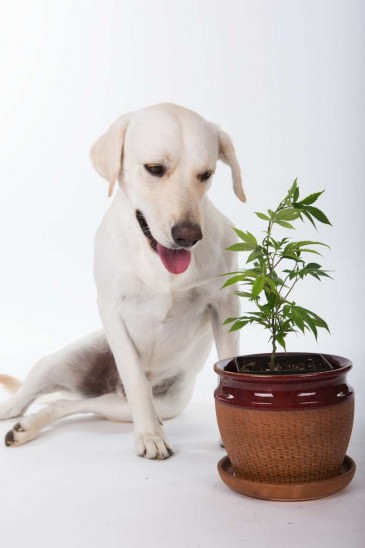Cannabis for Cats and Dogs
Unless you’ve been living in a cave for the past 5 years you have, no doubt read or heard on the news about the use of marijuana as a medicine for a number of disease problems, including epilepsy and pain.
Perhaps you’ve wondered if this newly-emerging herbal extract could be of some help for your pet? This column will discuss the potential uses for cannabis (which is the proper name for marijuana and hemp), potential problems with its use, and the best way to administer it to your pet. (No, its not by blowing smoke in their nose or ear!)
This is not about getting your pet “high”. Its about getting your pet “well”.
Background Information that is Important for you to Know
Marijuana comes from the type of cannabis plant that produces high levels of THC, otherwise known as Tetrahydrocannabinol. THC is the only part of the cannabis plant that is psychotropic, in other words, gets you high. There are nearly 65 other components of cannabis that are like THC almost all of which been found in research to possess some sort of medicinal property.
 THC and these other similar molecules, as a class, are called “Cannabinoids” and they are found only in the cannabis plant, except for a few exceptions. No other plant produces as large or as many cannabinoids as the cannabis plant. The major cannabinoid that has even more medicinal properties than THC and is not psychotropic like THC, is called Cannabidiol or CBD.
THC and these other similar molecules, as a class, are called “Cannabinoids” and they are found only in the cannabis plant, except for a few exceptions. No other plant produces as large or as many cannabinoids as the cannabis plant. The major cannabinoid that has even more medicinal properties than THC and is not psychotropic like THC, is called Cannabidiol or CBD.
The marijuana plant has high THC, but relatively low CBDs, and is not a very fibrous plant. This is in comparison to the hemp plant, both of which are of the cannabis species. In hemp you have such low levels of THC that it does not get you high, but it has, unlike marijuana, very high levels of CBDs. Hemp plants are known for their high fiber content which can be manufactured into paper, fabric, rope, and even building materials. Many people don’t know that the first American flag, sewn by the legendary Betsy Ross, was made from hemp cloth, as were the uniforms of the Revolutionary War soldiers!
In studies performed in the 1970s, when the US government was learning more about marijuana to see if it could be turned into a weapon, they tested THC on dogs and a number of other species, including pigeons, rats and monkeys. What they found was that the dog has the highest number of THC receptors (now called CB1 receptors) in its cerebellum. This brain structure is responsible for coordinated movement. So, when dog who hasn’t had THC before is given some it can have an adverse reaction known as “Static Ataxia”, in which they look like they are stoned, and stand on all four legs with feet held wide, and can’t move forward or backward, they just stand there and rock back and forth, possibly drooling some too. With much higher doses they will fall down, unable to get up, and may mess on themselves. In very rare cases with very large doses, or when the marijuana is cooked into an edible with chocolate, which is also toxic to dogs, several dogs have been reported to die.
Even though marijuana is considered safe in humans, it is riskier to use in dogs.
This means that if you give your dog some marijuana, even a small amount, it may have this reaction. If, for instance you live in a state with legal medical marijuana, and you purchased legally an edible treat for yourself, if you leave that out on the coffee table and your dog, or your child accidentally eats it, you may be needing to take them to your local Emergency Room for observation and detoxification.
In other articles in this column I will discuss:
- How to introduce medical marijuana to your pet to help avoid these emergencies.
- The use of hemp extracts instead of marijuana for your pet, which have minimal levels of THC, so they are not psychotropic, but contain high levels of CBDs which have many medicinal benefits.
- How to dose the medical marijuana or medical hemp to best benefit your pet.
- Potential medical applications for hemp and marijuana in pets
- Legal issues with the use of these herbal extracts.
- Research studies that help us to understand cannabis therapies better
- Basic scientific information about cannabis and how it works in the body through the endocannabinoid system.
- How to make your own extracts of cannabis if you live in a state where it is legal.
- Some of the interesting history of cannabis, that has been a part of human culture since before the time of recorded history
- Dispensary products: Which ones are safer to use than others for your pets.
- Hemp-based pet products to guide you in your decision about what is the best product for your pet’s needs.
- I will answer specific questions you may have about your pet and the potential benefit or risk to giving it cannabis.
- I will share stories from practice about successes and failures of cannabinoid therapies in animals.
VIEW ALL POSTS ABOUT CANNABIS




